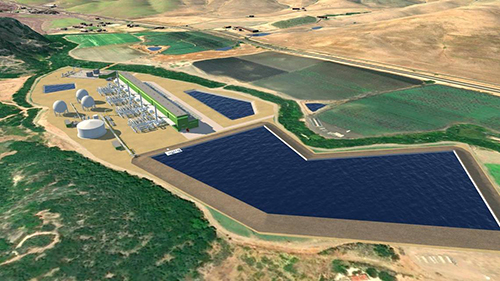Here’s a conceptual rendering of what Hydrostor of Canada’s proposed 400-megawatt energy storage plant in Chorro Valley would look . Rendering courtesy Hydrostor
A Canadian energy company has applied to build a huge energy storage/power plant on farmland in Chorro Valley, seeking to take advantage of the extensive electrical infrastructure already in place on the North Coast of SLO County.
Hydrostor on Nov. 23 filed an application with the California Energy Commission to build a 400-megawatt energy storage facility near the intersection of Hwy 1 and Canet Road, at the base of Hollister Peak.
The land is productive farmland and Hydrostor said in a news account that it had secured development rights to the land.
The project is very different than a proposed 600 MW Battery Energy Storage System or BESS plant that Vistra Energy is pursuing for its Morro Bay Power Plant property.
The Pecho plant would be an “Advanced Compressed Air Energy Storage” plant, which takes in energy to power air compressors that pressurize belowground water tanks to store that energy, albeit in a different form.
When the energy is needed, the plant blows the compressed air up through turbines that turn generators and recreate the electrical power.
The plant would use the 230,000-volt (230 KV) power lines that cross south to north near the site and end up at the Pacific Gas & Electric substation at the Morro Bay Power Plant.
From there the juice would transmit to the state power grid. It’s a technology that Hydrostor invented and owns the rights to. The plant will have the ability to deliver 400 MW per hour for 8 hours, according to Hydrostor. That’s more energy over a longer period of time than traditional battery plants, the company claimed.
“Pecho’s ability to deliver 400 megawatts of carbon-free electricity for eight hours will be comparable in size and resiliency to some of California’s largest fossil-fueled power plants,” the company said on its website. “Pecho’s quick-starting, flexible and dispatch-able, long-duration energy supply will have the ability to ramp-up and down through a wide range of electrical output.”
As a comparison, the Morro Bay Power Plant, when it was still operable, could produce 1,000 MW, burning natural gas to make electricity, and run 24/7.
Vistra’s BESS and Hydrostor’s Pecho plant have both stated intentions to use that same PG&E substation and high voltage wires. There is capacity available on those lines because the MBPP closed in 2014 and Diablo Canyon at 2,200 MW, is slated to close in 2025.
The Pecho plant is expected to cost some $800 million, and “will provide between 200 to 450 skilled labor jobs [average to peak] during its 4-years of construction,” the company said. “Once operational, Pecho will create 30 to 40 full-time equivalent, good paying jobs.
“The Project will also generate significant new property tax revenues for San Luis Obispo County and is expected to generate over $500 million in direct and indirect regional economic benefits during its commercial lifespan.”
The Energy Commission is apparently going to be the lead agency in the extensive permitting the project is going to need, including a full environmental impact report.
The site is in SLO County’s jurisdiction, so the County will likely have a big say in whether it gets built, just as the City of Morro Bay held the reins for Duke Energy’s failed attempt to replace the old Morro Bay Power Plant back in the early 2000s. The Energy Commission also headed that project up.
One obvious issue will be land use, and though the County’s zoning regulations for ag lands are pretty flexible (Morro Bay’s sewer treatment plant is being built on ag land in County jurisdiction), a facility such as this is something new.
Curtis VanWalleghem, CEO of Hydrostor, said in the news release, “Today’s filing marks the first of many important milestones in the implementation of Hydrostor’s commitment to helping California meet its recognized long-duration energy storage needs.
“Deployment of Hydrostor’s unique combination of being a proven, cost effective and carbon-free long duration storage solution will greatly enhance California’s program to fully transition to a reliable and carbon-free energy future. Our A-CAES facilities are designed to operate safely and efficiently for over 50 years with zero degradation.
“We look forward to working closely with the citizens of San Luis Obispo County to earn their trust and support on our way to becoming a valued member of the community. Pecho complements our previously announced 500 MW, 4,000 MW-hour Gem Energy Storage Center located in Kern County.”
Whether the City of Morro Bay has much say in the project or shares in the property tax windfall remains to be seen. However, the City would be an interested party, as its lone drinking water well in Chorro Valley is near the site on Canet Road.
Hydrostor has put up a website discussing the project, see: www.hydrostor.ca/pecho-energy-storage-center.
The Energy Commission has yet to post anything on its website for the project, but it could be expected to and to hold public meetings in SLO County, as it moves the project through its permitting process.




